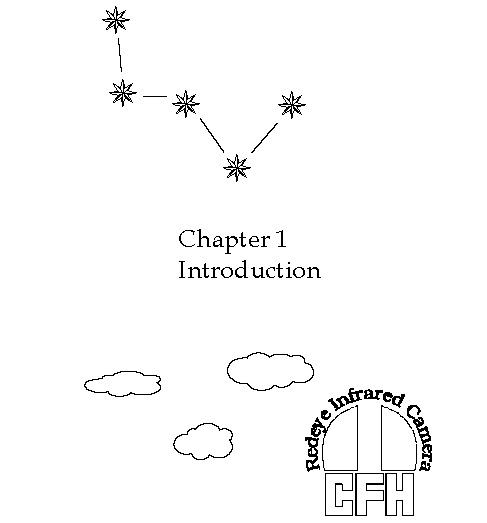




With the commissioning of Redeye in January, 1993, we expect that the cameras
will be in service for roughly 5 years, with perhaps a detector upgrade
somewhere along the line. In this time Redeye may be used as much as all
of the other array detectors (CCDs) combined, since they represent the
only CFHT window to the
1-2.5 m domain as facility instruments. Early
on we decided that Redeye would not be a "do everything" camera, opting
instead for a camera that offers exceptional sensitivity in a dewar that can
be mounted to a variety of existing instruments, that can be built in a
reasonable amount of time on a limited budget. We think we have been
successful to that end, building two cameras for nearly the price of one.
At the beginning of the project it was decided to pursue the rapid
development of a
1-2.5
m non-thermal camera first, then perhaps build
a more complex 1-5
m camera sometime thereafter.
With the recent work
on 8-10 m class telescopes on Mauna Kea though, the competitive viability
of a facility thermal camera at CFHT is questionable. As a result, the
second generation CFHT infrared camera will probably also only work in
the 1-2.5
m range but will use a much larger format
array and may include dispersing elements to support spectroscopy.
 disk mounted on the machine Uwila as are digitized transmission curves for
the Redeye stock filters and postscript versions of blank
observing log sheets. Alternatively, the postscript files can also be viewed
from the web by clicking here.
Additional copies are
available either at the CFHT headquarters in Waimea or on the summit.
If you wish to obtain any of these files via anonymous ftp manually, below is
an example of an ftp session used to remotely extract a chapter from
this manual. Bold text represents input.
disk mounted on the machine Uwila as are digitized transmission curves for
the Redeye stock filters and postscript versions of blank
observing log sheets. Alternatively, the postscript files can also be viewed
from the web by clicking here.
Additional copies are
available either at the CFHT headquarters in Waimea or on the summit.
If you wish to obtain any of these files via anonymous ftp manually, below is
an example of an ftp session used to remotely extract a chapter from
this manual. Bold text represents input.
local> ftp ftp.cfht.hawaii.edu Connected to uwila.cfht.hawaii.edu. 220-uwila.cfht.hawaii.edu FTP server (CFHT 3.55) ready. 220 Report any problems to ftp-bugs@cfht.hawaii.edu. Name (ftp.cfht.hawaii.edu:simons): anonymous 331 Guest login ok, send "user@host" as password. Password:simons@uwila 230 Guest login ok, access restrictions apply. ftp> cd pub/cfht-manuals/redeye 250 CWD command successful. ftp> get chapter1.ps.Z 200 PORT command successful. 150 Opening ASCII mode data connection for chapter1.ps.Z (22242 bytes). 226 Transfer complete. local: chapter1.ps.Z remote: chapter1.ps.Z 22352 bytes received in 0.38 seconds (58 Kbytes/s) ftp> close 221 Aloha. ftp> quitIn order to minimize transmission times and disk space requirements, the postscript version of this manual has been electronically compressed. Be sure to use the UNIX command 'uncompress filename' on the transmitted files before printing them. The postscript files are stored in separate chapters (with *.Z suffixes to indicate compression) so users can extract only the parts of the manual they are interested in. It is recommended that the Table of Contents be transmitted first, then printed out locally. From there any or all chapters that look useful can be transmitted. Be aware that the manual contains a large amount of embedded graphics, hence can take a fair amount of time to print on most postscript printers.
If a hard copy of the manual is not available on the summit (which tends to be the case since manuals develop legs rather quickly) it is straightforward to generate one locally with Wiki and the summit Sparc printer. To do this, first rlogin to Uwila from Wiki then 'cd ~ftp/pub/cfht-manuals/redeye'. Copy the files (i.e., chapters) you want to your local Wiki directory, then 'uncompress' and 'lpr' them to the summit printer via the command 'lpr -Psps filename'. Users with a X-environment available and a postscript viewer can peruse the manual without actually printing it out. The program "ghostview" is available on Wiki on the summit for this purpose.
Thanks to the software used to create this manual, modifying it should be much less cumbersome than past CFHT manuals, which relied heavily on "physical" cuts/pastes of text and graphics. Accordingly, during the first 1-2 years of Redeye's release, we expect to amend the manual periodically to reflect new performance specifications or observing modes available. After that, the manual will likely reach a "stable" era as Redeye matures.In order to determine how up-to-date the current version of the manual stored on the anonymous ftp disk is, there is a version number on the front page. Please check this version number before ftp'ing a new copy. As new versions are created the file "readme" will be updated to briefly describe new amendments or changes to the manual. Finally, while this manual represents the "first line" of information about Redeye to the CFHT community, if you cannot find the information you need about the cameras, or are concerned about getting the most up-to-date specifications possible, as always feel free to contact the CFHT technical staff or a resident astronomer. In particular, Dr. Jean-Luc Beuzit (beuzit@cfht.hawaii.edu) is currently on support duty for the Redeye cameras.


